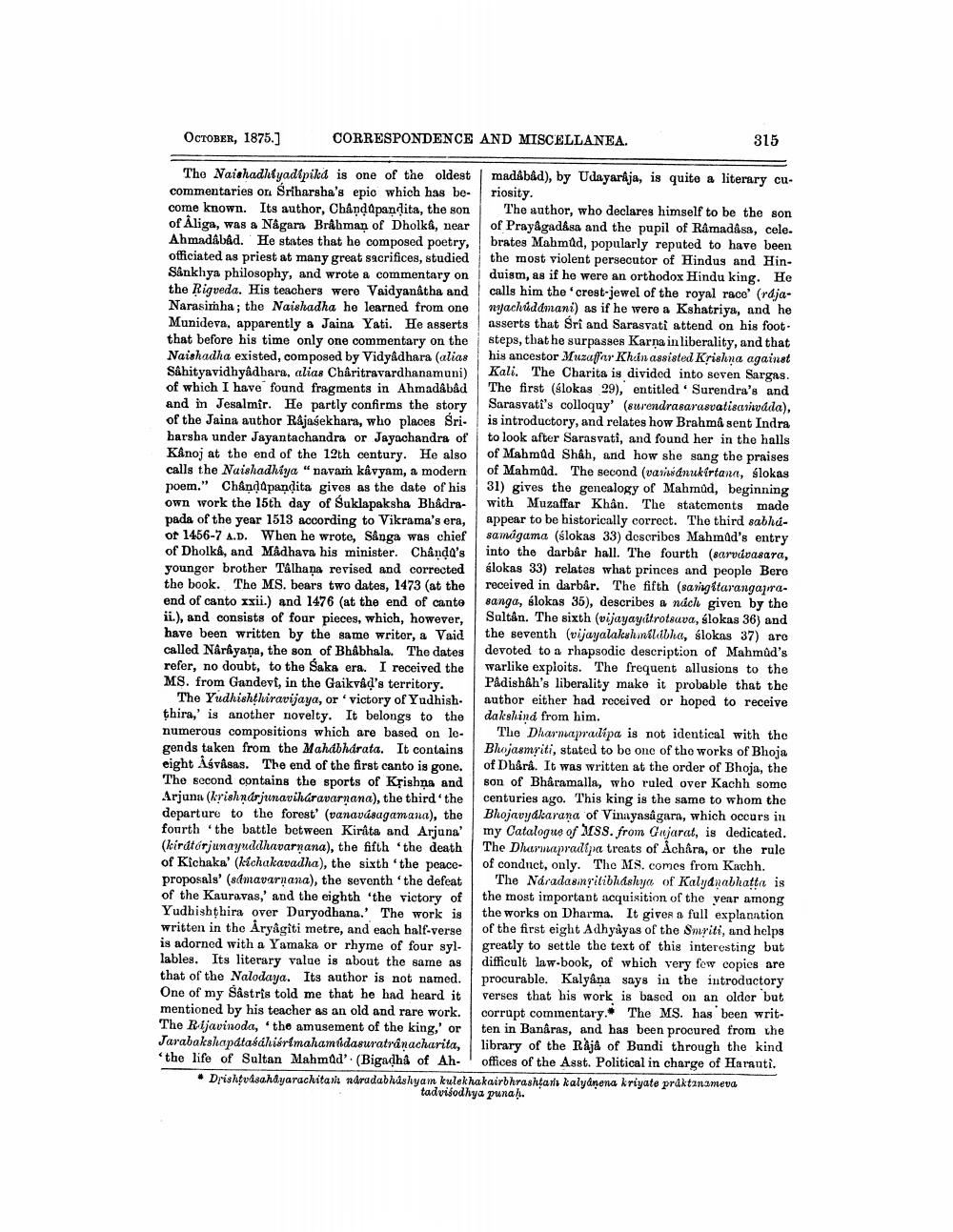________________
OCTOBER, 1875.]
The Naishadhiyadipika is one of the oldest commentaries on Sriharsha's epic which has become known. Its author, Chânḍapandita, the son of Aliga, was a Nagara Brahman of Dholka, near Ahmadabad. He states that he composed poetry, officiated as priest at many great sacrifices, studied Sankhya philosophy, and wrote a commentary on the Rigveda. His teachers were Vaidyanatha and Narasimha; the Naishadha he learned from one Munideva, apparently a Jaina Yati. He asserts that before his time only one commentary on the Naishadha existed, composed by Vidyadhara (alias Sahityavidhyadhara, alias Châritravardhanamuni) of which I have found fragments in Ahmadâbâd and in Jesalmir. He partly confirms the story of the Jaina author Rajasekhara, who places Śriharsha under Jayantachandra or Jayachandra of Kanoj at the end of the 12th century. He also calls the Naishadhiya "navam kavyam, a modern poem." Chandapandita gives as the date of his own work the 15th day of Suklapaksha Bhadrapada of the year 1513 according to Vikrama's era, of 1456-7 A.D. When he wrote, Sånga was chief of Dholka, and Madhava his minister. Chanda's younger brother Tâlhana revised and corrected the book. The MS. bears two dates, 1473 (at the end of canto xxii.) and 1476 (at the end of cante ii.), and consists of four pieces, which, however, have been written by the same writer, a Vaid called Narayana, the son of Bhâbhala. The dates refer, no doubt, to the Saka era. I received the MS. from Gandevi, in the Gaikvåd's territory.
CORRESPONDENCE AND MISCELLANEA.
The Yudhishthiravijaya, or victory of Yudhish. thira,' is another novelty. It belongs to the numerous compositions which are based on legends taken from the Mahabharata. It contains eight Asvâsas. The end of the first canto is gone. The second contains the sports of Krishna and Arjuna (krishnarjunaviháravarnana), the third the departure to the forest' (vanavasagamana), the fourth the battle between Kirâta and Arjuna' (kirátorjunayuddhavarnana), the fifth 'the death of Kichaka' (kichakavadha), the sixth 'the peaceproposals' (samavarnana), the seventh 'the defeat of the Kauravas,' and the eighth 'the victory of Yudhishthira over Duryodhana.' The work is written in the Aryâgîti metre, and each half-verse is adorned with a Yamaka or rhyme of four syllables. Its literary value is about the same as that of the Nalodaya. Its author is not named. One of my Sâstris told me that he had heard it mentioned by his teacher as an old and rare work. The Rljavinoda, the amusement of the king,' or Jarabakshapátaśáhisrimahamúdasuratrânacharita, 'the life of Sultan Mahmûd' (Bigadha of Ah
315
madâbâd), by Udayaraja, is quite a literary curiosity.
The author, who declares himself to be the son of Prayagadása and the pupil of Ramadâsa, cele. brates Mahmûd, popularly reputed to have been the most violent persecutor of Hindus and Hinduism, as if he were an orthodox Hindu king. He calls him the 'crest-jewel of the royal race' (rájanyachúddmani) as if he were a Kshatriya, and he asserts that Sri and Sarasvati attend on his footsteps, that he surpasses Karna in liberality, and that his ancestor Muzaffar Khan assisted Krishna against Kali. The Charita is divided into seven Sargas. The first (slokas 29), entitled Surendra's and Sarasvati's colloquy' (surendrasarasvatisanwada), is introductory, and relates how Brahmâ sent Indra to look after Sarasvati, and found her in the halls of Mahmûd Shah, and how she sang the praises of Mahmûd. The second (vamsdnukirtana, slokas 31) gives the genealogy of Mahmûd, beginning with Muzaffar Khân. The statements made appear to be historically correct. The third sabhúsamagama (slokas 33) describes Mahmûd's entry into the darbâr hall. The fourth (sarvávasara, slokas 33) relates what princes and people Bere received in darbâr. The fifth (samgitarangaprasanga, slokas 35), describes a nách given by the Sultan. The sixth (vijayaydtrotsava, slokas 36) and the seventh (vijayalakshmilabha, slokas 37) are devoted to a rhapsodic description of Mahmûd's warlike exploits. The frequent allusions to the Pâdishâh's liberality make it probable that the author either had received or hoped to receive dakshind from him.
The Dharmapradipa is not identical with the Bhojasmyiti, stated to be one of the works of Bhoja of Dhârâ. It was written at the order of Bhoja, the son of Bharamalla, who ruled over Kachh some. centuries ago. This king is the same to whom the Bhojavyakarana of Vinayasagara, which occurs in my Catalogue of MSS. from Gujarat, is dedicated. The Dharmapradipa treats of Achâra, or the rule of conduct, only. The MS. comes from Kachh.
The Náradasmyitibháshya of Kalyanabhatta is the most important acquisition of the year among the works on Dharma. It gives a full explanation of the first eight Adhyayas of the Smriti, and helps greatly to settle the text of this interesting but difficult law-book, of which very few copies are procurable. Kalyana says in the introductory verses that his work is based on an older but corrupt commentary. The MS. has been written in Banâras, and has been procured from the library of the Raja of Bundi through the kind offices of the Asst. Political in charge of Haranti. * Drishtvásahâyarachitam náradabhashyam kulekhakairbhrashtam kalyanena kriyate pråktznameva tadvisodhya punaḥ.




